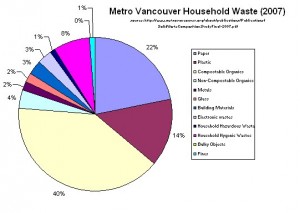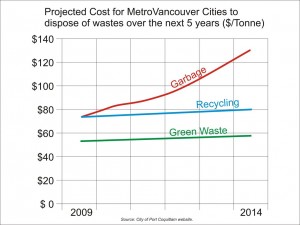According to Metro Vancouver’s waste surveys, 40% of household waste (by mass) is compostable organics. That means, of the average Metro Vancouver household’s 834kg of annual garbage, about 334kg is organic material that will compost. Notably, some organics, like fabrics and leather, do not readily compost, so they are not included in this 40%, nor are things like paper that do compost, but are classified under “recyclables”.

Read that again. The “average” Metro Vancouver household puts a third of tonne of compostables to the curb every year.
The vast majority of the rest of what goes to the curb is recyclable through the blue-box program or through the City’s recycling centre. Therefore, through recycling and composting, we can significantly reduce the amount of trash that goes to landfill or WTE. Every kilogram of trash we divert from the garbage truck, we save tax dollars used to pay tipping fees to dispose of the trash, we save the expense of moving garbage about, we reduce the need to burn diesel, we reduce the negative environmental impacts of trash incinerators and landfill leachate, we save landfill space. So can we agree that indiscriminately throwing trash to the curb is not a sustainable activity?
However, not all compostable organics are suited for the back-yard garden composter. Things like meat, bones, milk products, and fat get really stinky as they rot, and attract rats and other pests. They also encourage the production of methane, or sulphur compounds that we generally want to avoid both for the ecosystem of the compost, and for greenhouse gas reasons. Weeds like chickweed or creeping buttercup, when placed in your garden compost, will spread to new areas of your garden when you apply the compost. Therefore, the traditional backyard compost (where most of my kitchen scraps go) is unsuited for these wastes.
We have three options to manage this stuff not suited for the traditional garden compost:
Option 1: We put it in our new Clean Green Organics bin, provided by the City. The City then takes this material and ships it to a commercial composting company. There the material is shredded and composted in a high-oxygen environment, to reduce the production of methane and sulphur gasses, and is made back into commercial-grade compost, used mostly in parks and other City gardens. The reason the City does this is simple: they pay about half the tipping fees for this material than they do for “regular” garbage going to the landfill or incinerator. Therefore, your garbage utility tax goes down.
3: we do what Conservatives always suggest: we take personal responsibility for our own situation, and instead of relying on the “nanny state” or the “suffering taxpayer”, we simply install a Green Cone in our back yard and throw the small proportion of organics that would foul our composter into there instead. We remove the personal need for Clean Green Organic waste collection, we reduce the collective need for expensive incinerators or landfill technology, we save the poor, beleaguered taxpayer money.
All for the price of about 10kg of plastic. Oh, and the Green Cone is made of 100% recycled plastics, and is 100% recyclable with today’s plastic recycling technology. “Anonymous” suggested it would be destroyed by the sun within 8.3 years, but it is guaranteed for 10 years, and there are many of them out there in the world that have been functional for more than 20 years.
Again, I like the math of the Green Cone. It looks good on paper. However, part of the purpose of my having one is to evaluate how useful and practical it really is. I will report back.

Because we use our new trash bins our garbage utility tax is going down ?
Lets do the math on “recycled” plastics. First gen plastic is created as a by product of cracking crude then doping it with chemicals to make it nice and flexible rather then brittle.
It’s used and discarded for recycling. It’s now washed with fossil fuel heated potable water. It’s re-melted with fossil fuels and doped with more chemicals to make it nice. Then it’s trucked about from plastic plant to industry to market to your house.
Recycled plastic means more energy.
Recycled plastic means more money.
Recycled plastic means more chemicals.
The chemicals in plastic mimic estrogen.
Enjoy spreading that compost !
so your point is what? Don’t use plastic? Using plastic only once then throwing it out is more sustainable?
And what does this have to do with composting my own organic wastes?
I’ve never seen plastic grow in a garden.
Placing “organic” waste into a “green” plastic cone doped with chemicals doesn’t seem all that “organic” to me.
Eventually your going to have to open that “green” plastic cone and remove the remnants. You really don’t believe it all disintegrates into thin air do you ?
Hey, here’s an idea…. why not build a compost box made out of 100% organic wood with 0% marketing BULLSHIT.
Thanks for the constructive input, and eloquent use of language. Funny, I actually use my compost in lieu of fertilizing with cow manure, and that compost comes, as you suggest, from the wood-and-chicken-wire compost box where most of my compostables go. The Green Cone is specifically designed to manage things you don’t want to put into a traditional composter (which should be clear to anyone with grade four reading comprehension who reads the posts you are commenting upon).
Some of the material that goes into the Green Cone does indeed disappear into thin air. Much of the mass is water, which disappears into groundwater or evaporates off as water vapour. Much of the carbon is converted into CO2, and a little methane (enter ridiculously uninformed climate-change-denier comments here). Most of the residual material is moved into the soil through the actions of bacteria, worms, nematodes, insects, and other soil organisms. So it doesn’t disappear into thin air, it enters the ecosystem just like any other organic material.
Still, there are residuals that are left behind, and there will be build-up in the Green Cone. Based on common experience (this device has been around for 20+ years), a family of four will “fill” the cone in about 3 or 4 years. At that time, you dig out the cone, and add the “residuals” to your normal compost pile. By now, it is degraded enough that it is basically potash, and adds nutrients to your compost, but does not attract vermin or smell up your yard.
You really hate plastic, don’t you?
I see, your writing at a grade four comprehension level. Well then, lets take this up a grade shall we.
You suggest that placing items like meat wastes, odorous substances and noxious weeds require a method of extended compost times, and I agree, a 2 year cycle for the pathogens that can be harbored in the mass is required before spreading it all over your prized lettuce.
Therefore, when you realize your “green” plastic cone is full you will have to wait 2 years before you empty the remnants as the entire mass may be contaminated with pathogens from your more recent deposits of “organics”.
Much of the water mass you describe as leaching into the ground from the “green” plastic cone will also carry these pathogens.
I don’t fully comprehend how bacteria, worms, nematodes, insects, and other soil organisms are transporting the material outside the “green” plastic cone, well, other then fly breeding !
Let’s see:
Plastic for profits, mass production, economies of scale, photo-degradation of plastic, economies of recycling, estrogen mimicry, chemical contamination, mass balance, marketing bullshit, pathogens, flies…
Gish-gallop much?
Great post, Patrick! I didn’t know about the cost savings to the city (and us) by using the green bins. The bins have been awesome- I can’t believe how light my trash is each week.
One thing it’s done, too, is made our household more aware of the packaging on our products — because that’s pretty much all that’s in the garbage now — so we have a manageable goal to seek our more recyclable packaging when we head to Superstore every couple weeks.
Thanks again.
Chris @ the NewsLeader